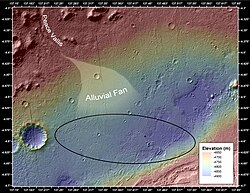Peace Vallis
 Peace Vallis and related alluvial fan near the Curosity rover landing ellipse and landing site (Bradbury Landing) (noted by +). | |
| Coordinates | 4°13′S 137°14′E / 4.21°S 137.23°E |
|---|---|
| Length | 35.24 km (21.90 mi) |
| Naming | adopted by the IAU on September 26, 2012 after a "River in British Columbia and Alberta, Canada".[1] |
Peace Vallis is a valley network in Gale Crater in the Aeolis quadrangle on the planet Mars; it appears to have been carved by fluids, perhaps water.[2][3][4] The valley 'flows' southeast down out of the hills of Gale Crater to Aeolis Palus below near Mount Sharp and is centered 4°13′S 137°14′E / 4.21°S 137.23°E.[1] Peace Vallis is near the landing site (Bradbury Landing) of the Curiosity rover which started studying the valley in 2012. The name Peace Vallis was officially adopted by the IAU on September 26, 2012.[1]
Curiosity rover landed near the end of the Peace Vallis fan. Peace Vallis fan covers 80 km2 (31 sq mi) and obtained water from an area of 730 km2 (280 sq mi). Peace Vallis enters Gale Crater through a 15 km-wide (9.3 mi) gap in its rim. Calculations suggest that the fan has an average thickness of 9 m (30 ft). Numerous inverted channels are visible on the western surface of the fan. Runoff through Peace Vallis that made the fan is estimated to be between 600 and 6,000 m (0.37 and 3.73 mi); therefore a hydrologic cycle probably lasted at least thousands of years. The water that flowed in Peace Vallis is believed to be from precipitation, possibly in the form of snow.[5][6]
Images
-
Map of actual (and proposed) Rover landing sites including Gale Crater.
-
Gale Crater - Landing site is noted - also, alluvial fan (blue) and sediment layers in Aeolis Mons (cutaway).
-
Curiosity rover landing site (green dot) - Blue dot marks Glenelg Intrigue - Blue spot marks the base of Mount Sharp - a planned area of study.
-
Layers at the base of Aeolis Mons - dark rock in inset is same size as the Curiosity rover (white balanced image).
-
Aeolis Mons in Gale Crater as viewed from the Curiosity rover (August 9, 2012) (white balanced image).
-
Gale Crater rim about 18 km (11 mi) North of the Curiosity rover (August 9, 2012).
-
First-Year and First-Mile Traverse Map of the Curiosity rover on Mars (August 1, 2013) (3-D).
See also
|
|
References
- ^ a b c "Gazetteer of Planetary Nomenclature: Peace Vallis". IAU. September 26, 2012. Retrieved September 28, 2012.
{{cite web}}: Cite uses deprecated parameter|authors=(help) - ^ a b Brown, Dwayne; Cole, Steve; Webster, Guy; Agle, D.C. (September 27, 2012). "NASA Rover Finds Old Streambed On Martian Surface". NASA. Retrieved September 28, 2012.
- ^ a b "NASA's Curiosity Rover Finds Old Streambed on Mars - video (51:40)". NASAtelevision. September 27, 2012. Retrieved September 28, 2012.
{{cite web}}: Cite uses deprecated parameter|authors=(help) - ^ a b Chang, Alicia (September 27, 2012). "Mars rover Curiosity finds signs of ancient stream". AP News. Retrieved September 27, 2012.
- ^ Palucis, Marisa C. "The origin and evolution of the Peace Vallis fan system that drains to theCuriositylanding area, Gale Crater, Mars". Journal of Geophysical Research: Planets. 119: 705–728. Bibcode:2014JGRE..119..705P. doi:10.1002/2013JE004583.
- ^ Palucis, M.; Dietrich, W.; Hayes, A.; Williams, R.; Gupta, S.; Mangold, N.; Newsom, H.; Hardgrove, C.; Calef, III; Sumne, D. (2014). "The origin and evolution of the Peace Vallis fan system that drains to the Curiosity landing area, Gale Crater, Mars". Journal of Geophysical Research: Planets. 119: 705–728. Bibcode:2014JGRE..119..705P. doi:10.1002/2013je004583.













